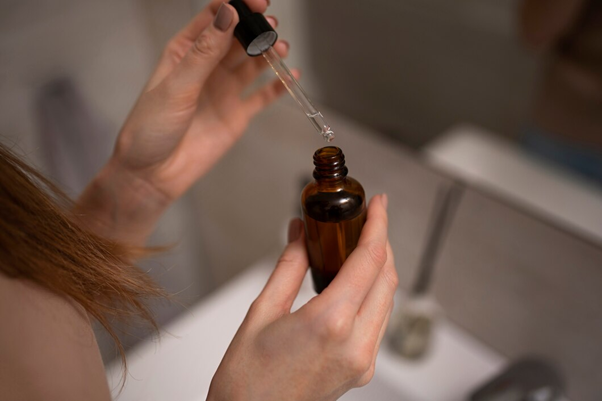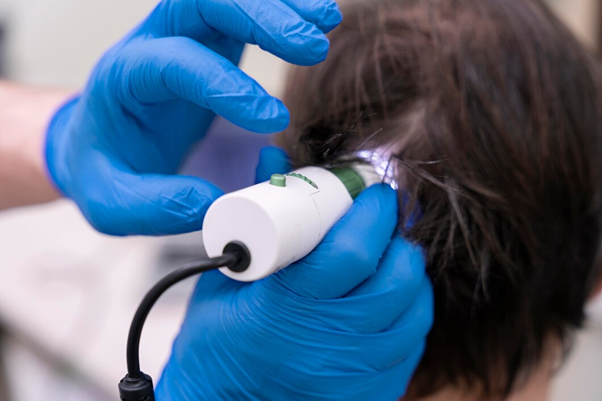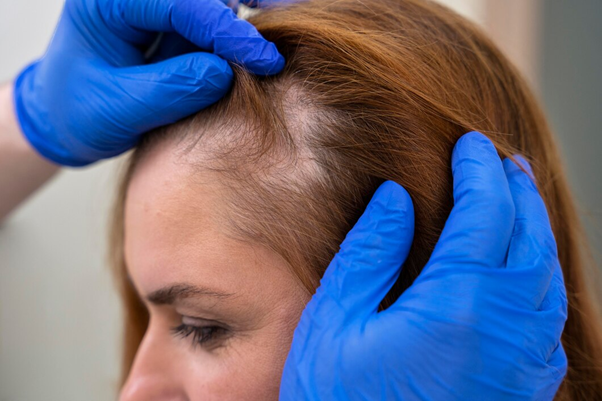Introduction
Female baldness, including the specific concern of a receding hairline at the vertex, can be a distressing issue for women in Mumbai. This common type of hair loss significantly impacts self-esteem and overall well-being. Consequently, seeking effective female baldness treatment in Mumbai has become a priority for many women aiming to regain their confidence and sense of self. This article delves into the top treatments available to combat this specific hair loss challenge.
Understanding Female Baldness
Causes of Female Baldness
Female baldness, or female pattern hair loss (FPHL), is primarily driven by hormonal changes, genetics, and ageing. Other contributing factors include medical conditions, medications, and lifestyle choices. Understanding the root cause is the first step toward finding an effective treatment.
Common Patterns of Hair Loss in Women
Women typically experience hair thinning rather than complete baldness. The thinning often starts at the part line, extending to the top of the head. Unlike men, women rarely develop a receding front hairline but may notice a widening part and thinning at the vertex.
Identifying the Receding Hairline at the Vertex
Signs and Symptoms
Early signs of a receding hairline, particularly at the vertex of scalp, include increased hair shedding, visible scalp through thinning hair, and a noticeable widening of the part line. It’s essential to monitor these symptoms to address the issue promptly.
Stages of Progression
Hair loss at the vertex can progress through several stages, from mild thinning to more severe hair loss. Recognising these stages helps in selecting the most appropriate treatment to manage and potentially reverse the condition.
Medical Treatments
Minoxidil (Rogaine)
Minoxidil is a popular treatment for female baldness that works by stimulating hair follicles and increasing blood flow to the scalp. It prolongs the hair growth phase, encouraging new hair growth and slowing down hair loss. When applied topically, users typically notice results within 3-6 months, but consistent use is essential for maintaining these results.
Finasteride
Finasteride, primarily used for male hair loss, can also benefit postmenopausal women experiencing hair thinning. By blocking the hormone responsible for hair follicle shrinkage, it can reduce hair loss and promote regrowth. However, finasteride carries risks like hormonal imbalances and potential birth defects, making it unsuitable for women of childbearing age. Always consult a doctor before starting finasteride to determine if it’s safe and effective for your specific condition.
Natural Remedies
Essential Oils

Lavender, rosemary, and peppermint essential oils offer a natural solution for hair loss. These potent oils can invigorate the scalp, stimulate hair growth, and provide a soothing sensation. To harness their benefits, mix a few drops of your chosen essential oil with a carrier oil like coconut or olive oil, and gently massage into the scalp. Leave on for at least 30 minutes before rinsing.
Nutritional Supplements
A balanced diet is key for healthy hair, as essential nutrients like biotin, zinc, and iron support hair growth and prevent loss. While these can be obtained through food, supplements such as biotin, vitamin D, and omega-3 fatty acids are often recommended for additional hair and scalp health benefits.
Lifestyle Changes
Diet and Nutrition
A healthy diet can significantly impact hair growth and overall scalp health. Nourishing your hair from within is key to achieving healthy growth. Incorporate foods rich in protein, iron, and vitamins, such as eggs, spinach, and salmon, into your diet to provide essential nutrients for hair follicles. Remember, staying hydrated is equally important as it helps maintain the overall health of your hair and scalp, contributing to a luscious and vibrant mane.
Stress Management
Stress is a significant factor in hair loss, making stress management techniques vital. Chronic stress can accelerate hair loss by prematurely pushing hair follicles into a resting phase.To combat this, incorporating stress reduction techniques like yoga, meditation, and regular exercise into your routine can help lower stress levels and promote overall hair health.
Cosmetic Solutions
Hairpieces and Wigs
Hairpieces and wigs offer an immediate solution to hair loss, providing a natural look and boosting confidence. Selecting the perfect wig involves careful consideration of factors like material, fit, and style to achieve a natural and comfortable look. Once you’ve found your ideal wig, proper care is essential to maintain its appearance and longevity. Regular cleaning and appropriate storage are key to keeping your wig looking fresh and vibrant.
Scalp Micropigmentation
Scalp micropigmentation (SMP) is a cosmetic procedure that creates the illusion of fuller hair. Scalp Micropigmentation (SMP) is a non-invasive procedure that involves depositing tiny pigment dots on the scalp to mimic the appearance of hair follicles, providing immediate results. Aftercare is crucial for maintaining the pigments and includes avoiding excessive sun exposure and using gentle hair products.
Surgical Options

Hair Transplant Surgery
Hair transplant surgery offers a permanent solution to hair loss by moving hair follicles from a dense area of the scalp to a thinning one. There are two primary methods: FUT and FUE, each with its advantages. Recovery involves some downtime, and the full results typically appear within a year. To achieve optimal outcomes, careful post-operative care is crucial. Consulting with a specialist will help determine the best approach for individual needs.
Emerging Treatments
Platelet-Rich Plasma (PRP) Therapy
PRP therapy harnesses the power of your own blood to stimulate hair growth. By concentrating platelets containing growth factors, this innovative treatment rejuvenates hair follicles and promotes new hair growth. While many experience significant improvements, results can vary, and multiple sessions may be necessary for optimal outcomes.
Low-Level Laser Therapy (LLLT)
Low-Level Laser Therapy (LLLT) is a non-invasive hair loss treatment that uses laser light to stimulate hair follicles and increase blood flow to the scalp, promoting hair growth and reducing shedding. While painless and without known side effects, LLLT may require several months for noticeable results and is generally most effective for mild to moderate hair loss.
Psychological Impact and Support
Coping with Hair Loss
Hair loss can have a profound emotional impact, making psychological support essential. Feelings of embarrassment, frustration, and sadness are common. Acknowledging these emotions is the first step toward healing. Joining support groups or seeking counselling can provide comfort and practical advice for coping with hair loss.
Conclusion
Addressing female baldness, particularly a receding hairline at the vertex, involves a multifaceted approach. From medical treatments to lifestyle changes and psychological support, numerous options are available to help women regain their confidence and enjoy healthier hair. It’s crucial to consult with a healthcare professional to determine the most appropriate treatment plan tailored to individual needs.
Image by freepik (Free for commercial use)
Image by freepik (Free for commercial use)
Image by freepik (Free for commercial use)




